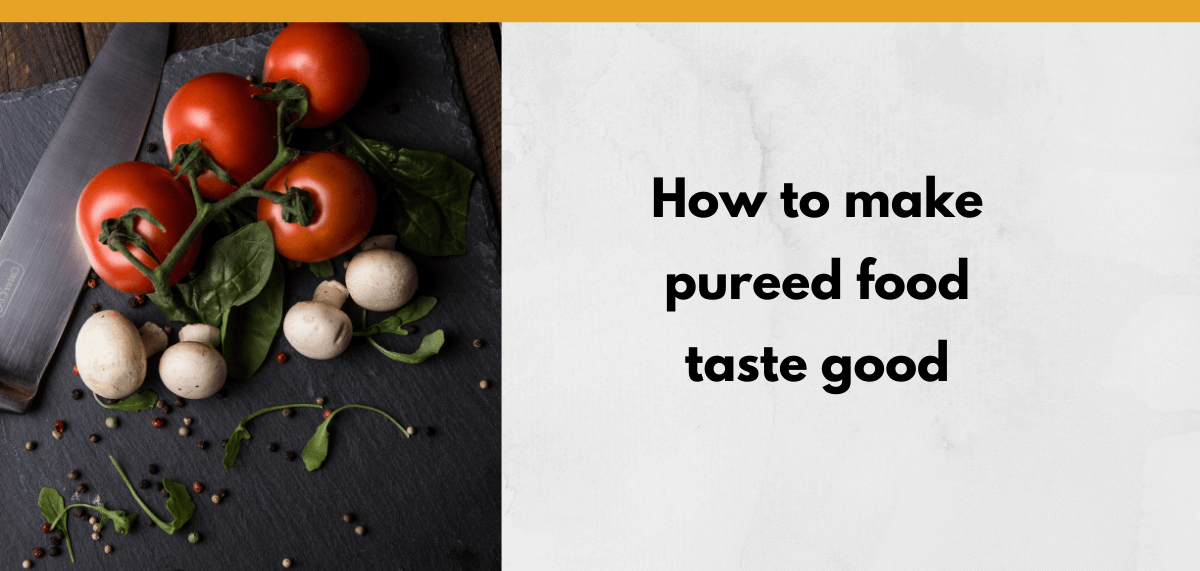I’m often asked how to make pureed food taste good. It’s easy to learn how to puree food, but then the question becomes how to get the best flavor and a nice variety. So I spent some time searching for good tutorials and videos showing how to make tasty recipes. Enjoy!
Free DIRECT download: How to puree vegetables and meat (patient handout). (Email subscribers get free access to all the resources in the Free Subscription Library.)
Outline:
- Tutorials for how to make pureed food taste good.
- Kitchen equipment for pureeing meals.
- Recipe videos.
- Related Eat, Speak, & Think posts.
Tutorials for how to make pureed food taste good
Learn the fundamentals of making a good puree in this 7-minute long video. It’s called “The Guide to Making Insanely Smooth Purees Out of Anything.” He starts off saying that whether you’re a chef or a home cook, learning how to make a good puree is a life skill and an art.
The French Cooking Academy will teach you simple techniques you can use to puree any vegetable.
Julie Effe will show you “a simple trick to help naturally thicken a puree to add more flavor”.
Learn how to puree meat with FoodServiceExpress (starts around 4:20).
FoodServiceExpress will also show you how to puree bread (starts at 6:50).
And finally, Graying With Grace shares a comprehensive guide to pureeing meals.
Kitchen equipment for pureeing meals
There are several different kinds of equipment you can use to puree foods. You can use a food processor, blender (better for foods with higher liquid content), or immersion blender. I recommend reading the product description and some of the user reviews before making a purchase.
Here are some example products. These are all affiliate links. At no additional cost to you, you may support Eat, Speak, & Think if you make a qualifying purchase.
Food processor
The Hamilton Beach Food Processor with Bowl Scraper (10 cups)* is good for pureeing (also chips, slices, and shreds). The bowl scraper attachment is handy for keeping the food close to the blades so you don’t have to keep stopping and scraping down the sides of the bowl.

Blender
I looked at the Ninja BL610 blender*, which is a popular device for pureeing fruits and vegetables, but the reviews suggest that the blades get dull rather quickly. So instead, I’d recommend the Vitamix E310 Explorian Blender*, which is highly rated but not as expensive as other Vitamix models.

Immersion blender
The KOIOS 800W immersion hand blender* is highly rated for pureeing food.

*This is an Amazon affiliate link. As an Amazon associate, I may
earn a small commission on qualifying purchases. There is no extra
charge to you, and it will help keep Eat, Speak, & Think
sustainable.
Recipe videos
Chicken
Barbecue chicken and chicken salad – demonstrated by Sherri Smith.
Chicken – demonstrated by Stephanie Wittek.
Chicken and potatoes – demonstrated by Josie Mae’s Meals.
Chicken pot pie – demonstrated by Cooking at Pam’s Place.
Chicken salad and Buffalo chicken dip – demonstrated by TimeToShrink.
Other meat and fish
Cheeseburgers – demonstrated by Sherri Smith.
Seared salmon puree – demonstrated by eHow Food.
Taco meat – demonstrated by The North Sleeve.
Main meals, sides, and smoothies
Egg salad – demonstrated by Sherri Smith (starts at 3:38).
Several recipes: Fruit & veggie shake, ricotta bake, refried beans, sweet potato, and protein pudding – demonstrated by TimeToShrink.
Raspberry and red cabbage smoothie and red cauliflower soup – demonstrated by Home Care Assistance.
Spinach dip – demonstrated by TimeToShrink (starts at 8:43).
Related Eat, Speak, & Think posts
- A practical guide to pureed food at home.
- Take the guesswork out of thickening liquids with the IDDSI flow test.
- How to help an adult with eating and drinking.
Free DIRECT download: How to puree vegetables and meat (patient handout). (Email subscribers get free access to all the resources in the Free Subscription Library.)
Featured image by Toni Cuenca from Pexels.
Lisa earned her M.A. in Speech-Language Pathology from the University of Maryland, College Park and her M.A. in Linguistics from the University of California, San Diego.
She participated in research studies with the National Institute on Deafness and other Communication Disorders (NIDCD) and the University of Maryland in the areas of aphasia, Parkinson’s Disease, epilepsy, and fluency disorders.
Lisa has been working as a medical speech-language pathologist since 2008. She has a strong passion for evidence-based assessment and therapy, having earned five ASHA Awards for Professional Participation in Continuing Education.
She launched EatSpeakThink.com in June 2018 to help other clinicians be more successful working in home health, as well as to provide strategies and resources to people living with problems eating, speaking, or thinking.



Be First to Comment